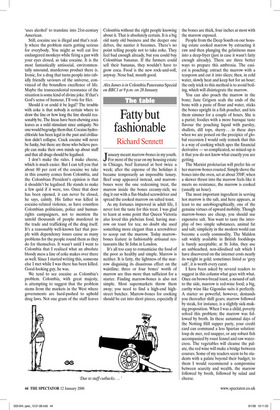Fatty but fashionable
Richard Sennett
January meant marrow-bones in my youth. For most of the year on my housing estate in Chicago, beef featured at best twice a week; after the expense of the holidays it became temporarily an impossible luxury. Beef soup appeared instead, and marrowbones were the one redeeming treat, the marrow inside the bones creamy-rich; we dug it out with a flat-bladed screwdriver and spread the cooked marrow on salted toast.
As my fortunes improved in adult life, I never lost the taste for this treat. I was glad to learn at some point that Queen Victoria also loved this plebeian food, having marrow on toast for tea; no doubt she used something more elegant than a screwdriver to scoop out the marrow. Today marrowbones feature in fashionably artisanal restaurants like St John in London.
It’s all too easy to romanticise the food of the poor as healthy and simple. Marrow is neither. It is fatty, the lightness of the marrow disguising its disastrous effect on the waistline; three or four bones’ worth of marrow are thus more than sufficient for a starter. Finding marrow-bones is also not simple. Most supermarkets throw them away; you need to find a high-end highstreet butcher. Marrow-bones for cooking should be cut into short pieces, especially if the bones are thick, four inches at most with the marrow exposed.
People from the Deep South on our housing estate cooked marrow by extracting it raw and then plunging the gelatinous mass into a deep-fryer (just in case it wasn’t fatty enough already). There are three better ways to prepare this ambrosia. The easiest is poaching: extract the marrow with a teaspoon and cut it into slices; then, in cold water, slowly heat and keep hot for an hour; the only trick to this method is to avoid boiling, which will disintegrate the marrow.
You can also poach the marrow in the bone; Jane Grigson seals the ends of the bone with a paste of flour and water, sticks the bones upright in a fish poacher, and lets them simmer for a couple of hours. She is a purist; foodies with a more baroque taste flavour the poaching liquid with parsley, shallots, dill tops, sherry ... in these days when we are poised on the precipice of global recession I would only remark that this is a way of cooking which apes the financial derivative — so complicated, so mixed-up is it that you do not know what exactly you are getting.
The Marxist proletarian will prefer his or her marrow-bones roasted. Simply shove the bones into the oven, set at about 350F; when a skewer thrust into the marrow feels like it meets no resistance, the marrow is cooked (usually an hour).
The most important ingredient in serving hot marrow is the salt, and here appears, at least to me autobiographically, one of the genuine virtues of upward mobility. Though marrow-bones are cheap, you should use expensive salt. You want to taste the interplay of two simple substances, animal fat and salt; simplicity in the modern world can become a costly commodity. The Maldon salt widely available in British foodshops is barely acceptable; at St John, they use an unbleached, non-idiodised salt which I have discovered on the internet costs nearly its weight in gold; sometimes listed as ‘grey salt’, it is worth every carat.
I have been asked by several readers to suggest in this column what goes with what. Once on brown-bread toast, a mound of salt to the side, marrow is red-wine food; a big, earthy wine like Gigondas suits it perfectly. A starter so powerful, however, demands you thereafter shift gears; marrow followed by steak, for instance, is a slightly sick-making proposition. When I was a child, poverty solved this problem; the marrow was followed by broth. In these autumnal days of the Notting Hill supper party, your credit card can command a less Spartan solution: loup de mer, red snapper, or any robust fish accompanied by roast fennel and raw watercress. The vegetables will cleanse the palate, the red wine will make a bridge between courses. Some of my readers seem to be students with a palate beyond their budget; to them I would recommend a compromise between scarcity and wealth, the marrow followed by broth, followed by salad and cheese.


























































 Previous page
Previous page